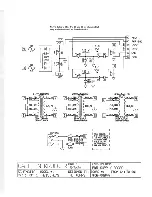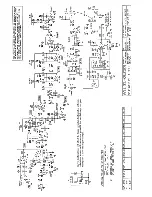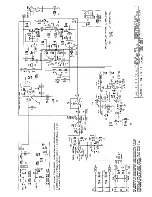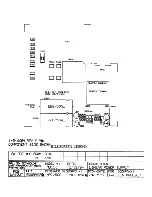
INPUT SET-UP AND SYSTEM GAIN TEST(contd.)
8)
Disengage limiter.
9)
Look at tip of headphone output jack (J4). Output should be about 1Vrms at this point.
10) Repeat step 9 looking at ring of headphone output jack.
TONE CONTROLS TEST
1)
Set all large knobs to center (12 o’clock), switches out, small knobs to 0.
2)
Set scope-B to 1V/cm and 2ms/cm.
3)
Set oscillator to 100Hz square wave at –46dBV.
4)
Look at output, compare to Fig. 1.
5)
One at a time, turn tone control knobs and compare output to figures (resetting each to center after finishing):
A)
Treble to 10- Fig. 2; Treble to 0- Fig. 3.
B)
Hi-mid freq. and level to 10- Fig. 4.
C)
Hi-mid to 0, level 10- Fig. 5.
D)
Hi-mid to 0, freq. on 0- Fig. 6.
E)
Lo-mid freq. and level to 10- Fig. 7.
F)
Lo- mid freq. to 0, level on 10- Fig. 8.
G)
Lo-mid level to 0, freq. on 0- Fig. 9.
H)
Bass to 10- Fig. 10; Bass to 0- Fig. 11.
VOICING FILTERS TEST
1)
Engage low-cut switch- compare to Fig. 12. Disengage.
2)
Increase contour to 10- compare to Fig. 13. Turn to 0.
3)
Increase hi-boost to 10- compare to Fig. 14. Turn to 0.
BOOST / CHORUS / BALANCED OUTPUTS TEST
1)
Increase boost to 10- compare to Fig. 15. Turn to 0.
2)
Change scope trigger to A and scope-A to 0.1V/cm range.
3)
Look at direct out (J4) pins 2,3 - compare to Fig. 16.
4)
Engage chorus switch with rate and depth to 0.
5)
Look at balance out-R(J3) pin 3 (center), compare to Fig. 17.
6)
It should have a small spike that moves back and forth approx. 1 division every 2-3 seconds.
7)
Increase rate to max. and spike travel should speed up to about once every .7 seconds. Rate to 0.
8)
Increase depth to max. and the spike should travel back and forth about 5 divisions. Depth to 0.
9)
Look at balance out-R pin 2(left). Spike should be slightly smaller than that in Fig. 17.
10) Engage 1-2 switch (S5)- J3 pin 3 changes, J3 pin 2 stays the same.
11) Compare balance out-L(J4) pins 2-3 to Fig. 17.
FOOTSWITCH TEST
1)
Set scope-B to 2V/cm, trigger to B.
2)
Connect RF2 to footswitch jack (J8) using stereo cord.
3)
Set boost to max and chorus switch in on front panel.
4)
Set RF2 switches so LED’s are off - compare to Fig. 1.
5)
Engage boost switch. Boost LED should light on footswitch.
6)
Compare output to Fig. 15. Disengage boost switch.
7)
Engage chorus switch. LED should light on RF2 and on front panel.
8)
Compare output to Fig. 18. Disengage chorus switch.
9)
Remove footswitch, set boost to 0.





















